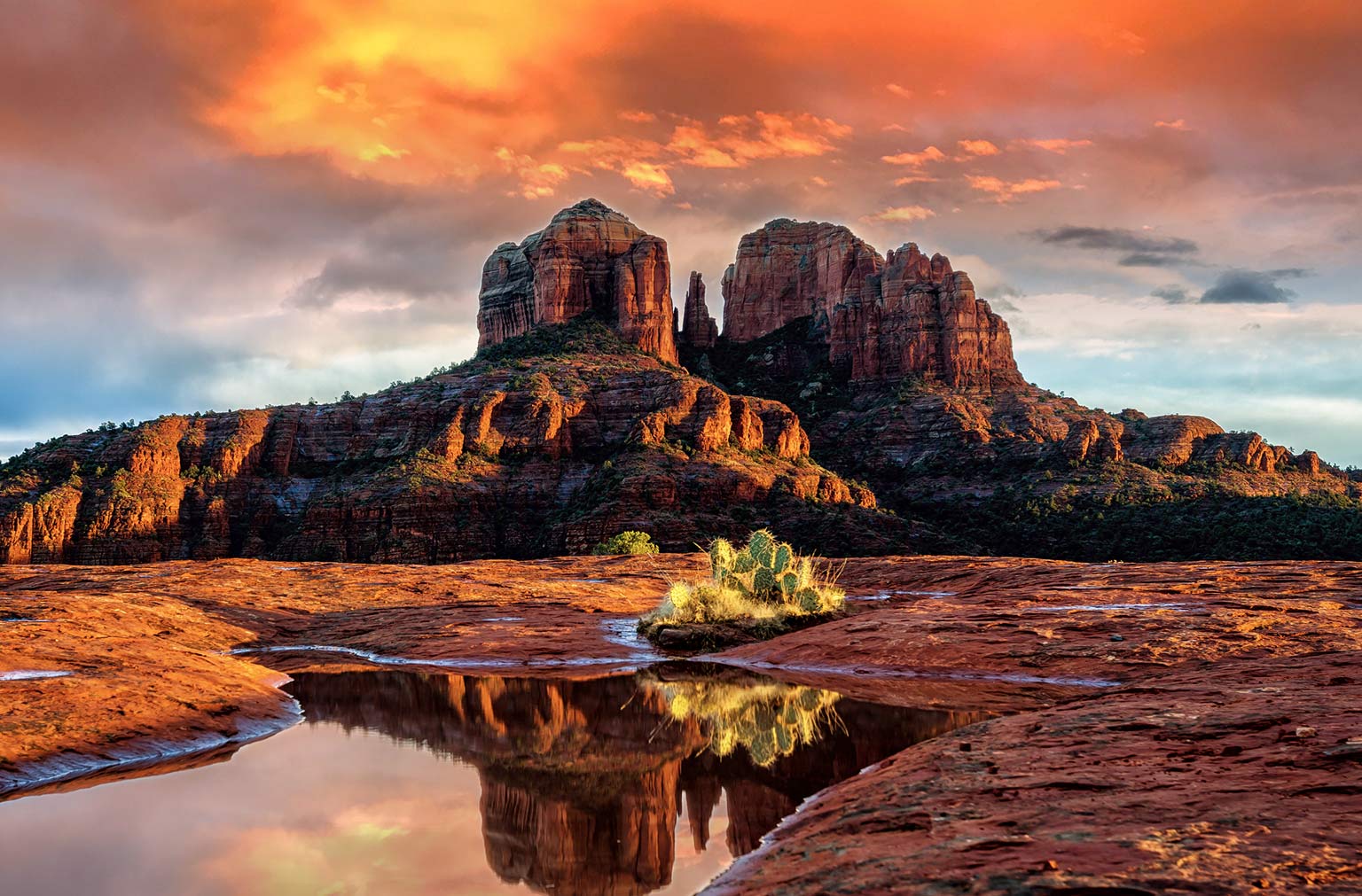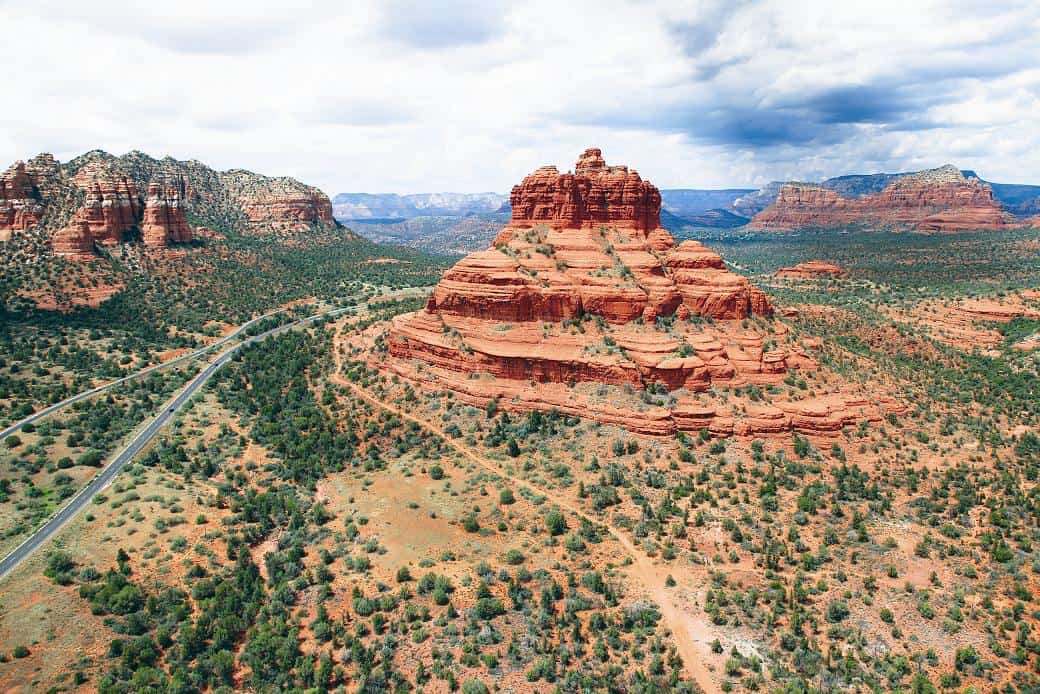A trip to the strangest thing in Arizona
Sedona is a place where geology, spirituality, and human experience come together in ways that continue to amaze and confuse people from all over the world. This desert town in Arizona's red rock country is surrounded by towering red formations. It has become known for one of the most interesting New Age phenomena of our time: the vortexes. People say that these are swirling centers of energy that can heal, change, and wake up the mind. But what are these strange things? Are they real things that can be measured, or are they just a beautiful mix of nature and faith?
The Beginning of a New Myth
Page Bryant came up with the story of Sedona's vortexes in 1980, not from ancient Native American traditions. Bryant, a psychic and metaphysical practitioner from Florida, moved to Sedona for a short time and said that during a channeling session, she made contact with an entity named "Albion." Albion, according to Bryant, showed her where certain energy centers were in the red rock landscape—places where the Earth's vital force was especially strong and easy to reach.
Bryant named these places "vortexes" and started making maps of them all over the Sedona area. Her 1987 book "The Sedona Vortex Experience" made these places famous and helped make Sedona a spiritual destination for people all over the world. After the 1987 Harmonic Convergence, when thousands of people gathered for synchronized meditations based on José Argüelles' interpretation of Mayan calendar prophecies, the phenomenon took off. Sedona became one of the main places where people came together, which helped it become known as a center of Earth energy.
Before Bryant, Sedona was mostly known for its beautiful rocks and as a place where Western movies were made. Anthropologists call the town's change into a spiritual center "invented tradition." This is a relatively new practice that gains the aura of ancient wisdom through repetition and group belief.

Theories and terms for understanding vortex energy
People who believe in vortexes say they are concentrated, spiraling earth energies that come up where the planet's electromagnetic field is especially strong. Practitioners have created a detailed system for classifying vortex energy into three main types:
People say that Electric (Masculine) Vortexes create upward, energizing flows that get people moving, creative, and expressive. People who visit often say they feel energized, inspired, or ready to make big changes in their lives. These sites are good for people who want to make decisions more clearly or get more creative.
People say that magnetic (feminine) vortexes create energies that pull things in, which makes it easier to think about yourself, heal emotionally, and be open to new things. People talk about feeling deeply at peace, letting go of their emotions, and connecting with their true selves. These places are good for meditation, thinking, and working through emotional wounds.
People think that balanced electromagnetic vortexes bring together both energies in a way that creates a space for integration and wholeness. These places are thought to be perfect for spiritual practices that need both grounding and elevation.
There are four main vortex sites: Airport Mesa is thought to be electric, Cathedral Rock is thought to be magnetic, Boynton Canyon is thought to be balanced, and Bell Rock is thought to have a unique mix of all three energies, making it the most powerful and popular place to visit.
The Science Behind the Feeling
Scientists are still not sure about vortex energy claims. Dr. Steven Semken, a geologist at Arizona State University who has studied Sedona's geology a lot, says that there is no accepted scientific evidence for the existence of "vortex energy" as New Age practitioners describe it. The geology of the area is beautiful, but it doesn't have any unusual electromagnetic properties that would set it apart from other desert areas.
But when we look at real measurements, the story gets more complicated. In 2016, independent researchers used electromagnetic field detectors to find small problems near Bell Rock and Cathedral Rock. These measurements showed small changes in the local electromagnetic fields, but they were still within the normal range for areas with iron-rich rock formations. Iron oxide (hematite) gives Sedona's red rocks their unique color. This mineral can affect local magnetic fields in ways that can be measured but aren't very interesting.
The twisted juniper trees that are often used as proof of vortex forces tell a more complicated story. These twisted, spiraling trees grow near a lot of places that people say are vortex centers. People who believe in them say that powerful energy fields have shaped them. Botanists and ecologists have a more straightforward answer: junipers grow in twisted patterns because of things like wind exposure, nutrient availability, soil conditions, and competition for sunlight. In the American Southwest, you can find similar twisted junipers in places that have nothing to do with vortices.
But it would be scientifically premature to dismiss the entire phenomenon as mere delusion. Studies in environmental psychology consistently show that natural settings, especially dramatic landscapes, have measurable effects on both the body and the mind. Research indicates that exposure to natural environments diminishes cortisol levels, lowers blood pressure, alleviates anxiety, and improves cognitive function.
A Detailed Look at the Four Sacred Sites
Airport Mesa
This site is easy to get to and sits on a mesa that used to be the town's airstrip. From here, you can see all of Sedona's famous formations in all directions. The trailhead is close to the airport, and a moderate hike takes you to a few places where you can see twisted junipers that are good for meditation.
Airport Mesa is an electric (masculine) vortex that draws people who want clarity, inspiration, and progress. Many people say they have had creative breakthroughs, new motivation, or clear ideas about where they want to go in life. The site is most popular at sunrise and sunset, when the changing light turns the red rocks into glowing sculptures.
Cathedral Rock
Cathedral Rock, which rises sharply above Oak Creek, is one of Sedona's most photographed and well-known formations. The unique spires look like Gothic architecture, which is why they are called that. To get to the formation, you have to cross Oak Creek (which can be hard when the water is high) and climb a steep, rocky trail to get to the saddle between the spires.
Cathedral Rock is a magnetic (feminine) vortex that is linked to self-reflection, emotional healing, and being open to new ideas. The difficult hike creates a natural barrier that keeps out some visitors. Those who make it to the top often say they have deep experiences of peace, emotional release, or spiritual insight.

Bell Rock
Bell Rock is one of the most famous formations in Sedona. It looks like a huge, rust-colored bell rising from the desert floor. Because of its unique shape and prominent location along Highway 179, it is easy to find and recognize. This is why it is Sedona's most popular vortex site.
People say that Bell Rock has a unique mix of all three types of energy, which makes it especially powerful for people who want balance, harmony, and alignment. There is a lot of interesting information about Bell Rock. Some people say it has buried crystals that boost energy, while others say it is a portal or landing place for UFOs.
Boynton Canyon
Boynton Canyon is a beautiful red rock canyon that opens to the west. It has a different vortex experience. The Enchantment Resort, one of Sedona's best luxury hotels, is located in the canyon. This creates an interesting contrast between nature and high-end service.
Boynton Canyon is a balanced (electromagnetic) vortex that is said to bring together masculine and feminine energies. The Yavapai-Apache Nation has traditional stories that link the canyon to stories about how the world was made. These stories make the canyon truly sacred to them.
Indigenous Viewpoints and Cultural Appropriation
The connection between Sedona's vortex phenomenon and Indigenous traditions is complicated and often makes people uncomfortable. The red rock country is very sacred to the Yavapai-Apache Nation, whose ancestral lands include the Sedona area. But not because of vortexes as Bryant defined them.
Yavapai creation stories say that the canyon lands are where people first came into this world. In their traditional stories, certain formations have meaning. For example, Boynton Canyon is mentioned in stories about protective spirits, and different rock formations are linked to certain people or events in tribal history.
Nonetheless, the contemporary vortex movement emerged independently from these traditions. When New Age practitioners talk about "Native American wisdom" in connection with vortex energy, they are usually doing what scholars call "spiritual appropriation." This means that they are using the authority of Indigenous cultures to make new practices seem more legitimate.
The Visitor Experience
Even though scientists are skeptical and the culture is complicated, thousands of people say they have had powerful experiences at Sedona's vortex sites. Common themes include:
- Physical Sensations: Tingling in hands or body, warmth or coolness, changes in pressure, or energy moving through them
- Emotional Responses: Unexpected emotional releases, crying, laughing, or feeling waves of joy, sadness, or peace
- Changes in perception: Time distortion, improved color perception, sounds seeming clearer or more dimensional
- Insights and Clarity: Sudden understanding, creative ideas, or deep thoughts about relationships, career, or personal purpose
- Or Just Awe: Deep appreciation for the beauty and grandeur of the landscape
The Vortex Economy
Sedona's vortex phenomenon has led to a large spiritual tourism economy. About 10,000 people live in the town, and it gets more than 3 million visitors every year. A lot of these visitors come for vortex tourism.
Vortex Tours: Many businesses offer jeep tours, hiking guides, and unique vortex experiences. Prices range from $75 to $200 per person.
Healing Services: Hundreds of practitioners offer energy healing, crystal therapy, aura readings, past-life regression, sound healing, and many other types of healing.
Metaphysical Retail: Sedona has many stores that sell crystals, spiritual books, sacred objects, and vortex-related items.
The Decision: Reality, Belief, and Significance
What can we conclude after looking at the evidence, history, and different points of view on Sedona's vortexes?
The scientific community agrees that "vortex energy," as described by New Age practitioners, has not been proven through rigorous testing. The red rocks in Sedona have geological and electromagnetic properties that can be measured, but they are not very different from other iron-rich formations.
But thousands of people who visit these places say they have meaningful, life-changing experiences there. People who have these experiences think they are real, even if the metaphysical explanation is not proven.
The most balanced view may be the one that sees Sedona as a place that offers something valuable, whether or not "vortex energy" is a real thing. The beautiful scenery, the break from everyday life, the visitors' intention and openness, the physical activity of hiking, and the freedom to look for meaning and change—all of these things come together to make it possible for people to gain insight, heal, and change.
The mystery persists in the interstice between quantifiable and experiential reality. Sedona reminds us that human experience is more than what we can see with our current tools. The vortexes may be gateways to higher consciousness or just beautiful places where people can stop, think, and change. Regardless, they still serve a purpose: they create sacred space in a secular world, give us hope for healing and growth, and remind us that there is still mystery in our universe.
